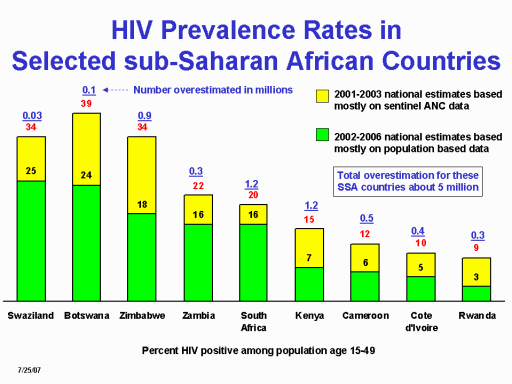| front |1 |2 |3 |4 |5 |6 |7 |8 |9 |10 |11 |12 |13 |14 |15 |16 |17 |18 |19 |20 |21 |22 |23 |24 |25 |26 |27 |28 |29 |30 |31 |32 |33 |review |
 |
Since
2001, UNAIDS has been forced to acknowledge drastically reduced HIV
prevalence estimates in over a dozen African, Caribbean and Asian
countries, as a result of well-designed "population-based"HIV
surveys (randomly selected samples of urban and rural populations). Results from Demographic and Health Surveys (DHS) that included HIV
testing (+) indicate that prevalence estimates in most of these high
HIV prevalence countries were too high by up to 2 to 3 times due to
the use of HIV sentinel surveillance (HSS) data that were heavily
biased by urban sentinel sites. For example, the national HIV
prevalence estimate of about 22% for Zambia in 2001 was based
primarily on HSS data from antenatal clinics.
In 2001, a population-based DHS that included HIV testing was carried out in
Zambia (ZDHS+)
and the national HIV prevalence was estimated to be much lower at about 16%.
Analysis of the different sampling methods used by these two national
surveys led to the conclusion that the HIV prevalence rate estimated by the
2001–2002 ZDHS+ is about the same as the prevalence rate estimated by ANC
surveillance when adjusted for the biased geographic coverage of
the ANC surveillance system.
Based on the
DHS+ and/or population-based surveys whose findings were available by
mid-to-late 2003, UNAIDS had to reduce some of their initial 2001 HIV
prevalence estimates by up to 50 percent or more – the 2001 estimate for
Kenya was 2.3 million and the revised 2001 estimate was 1.2 million, an
overestimate of more than a million or close to 100%. |